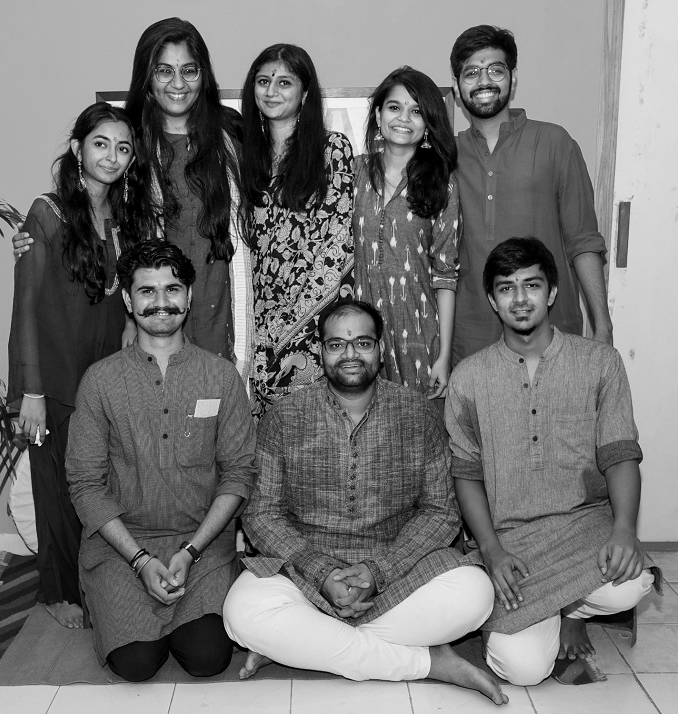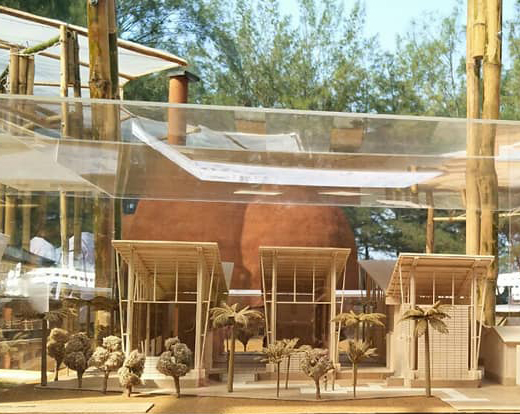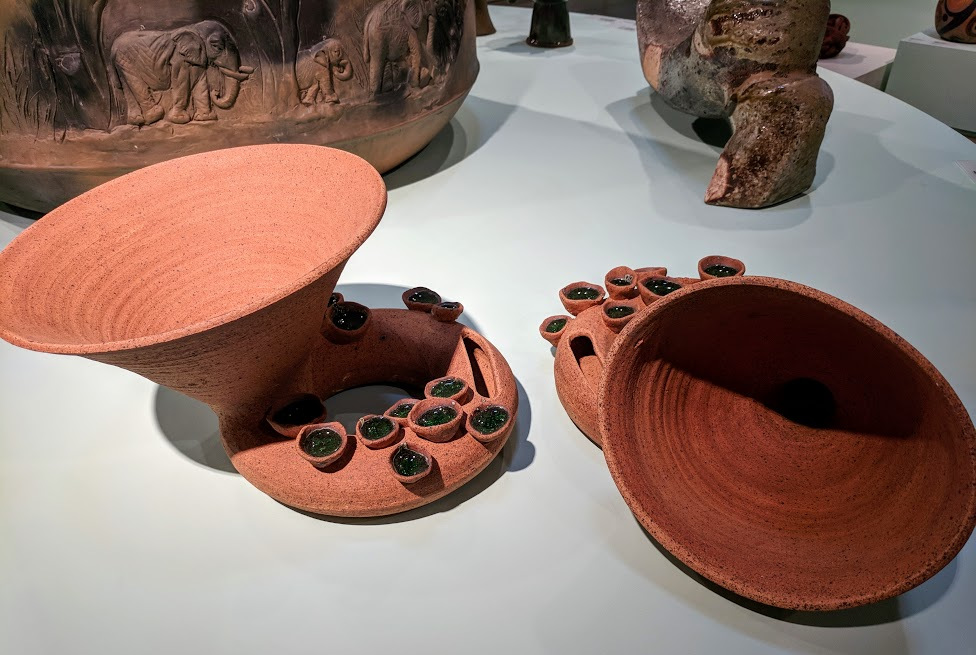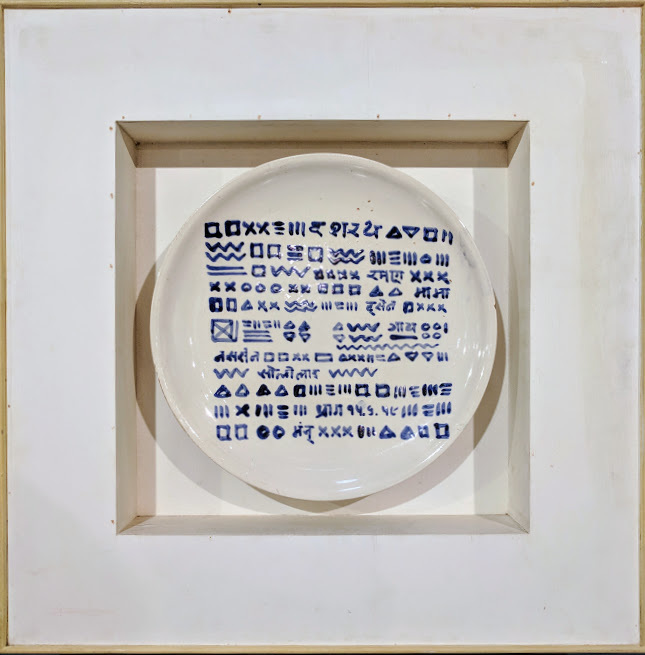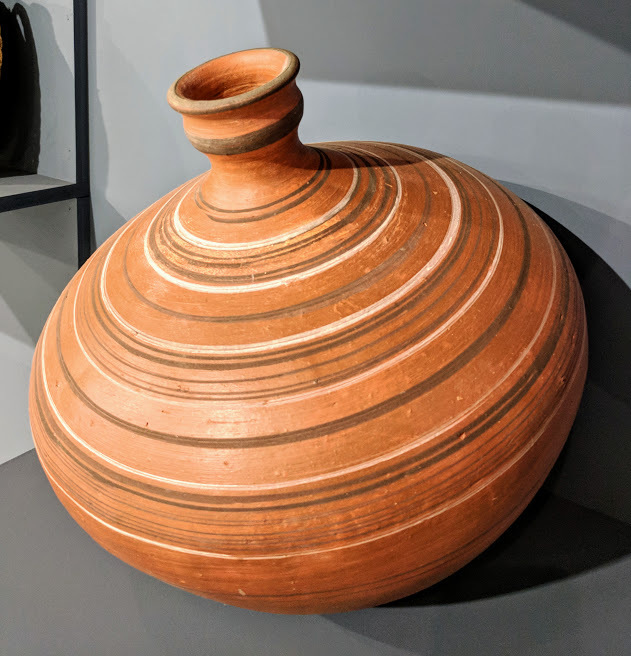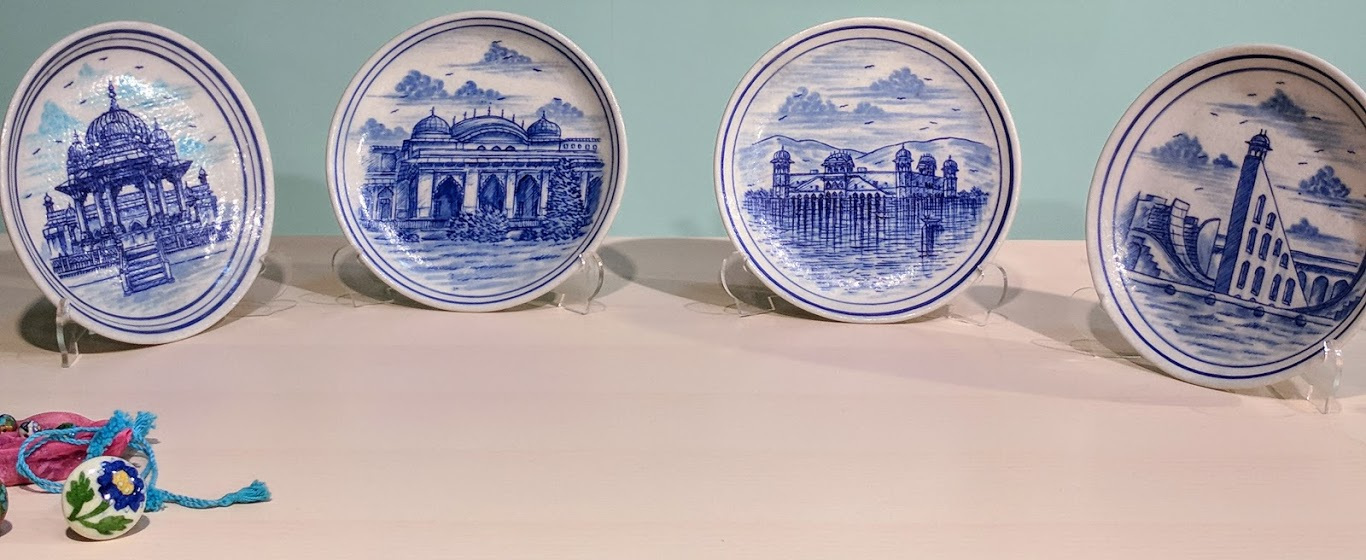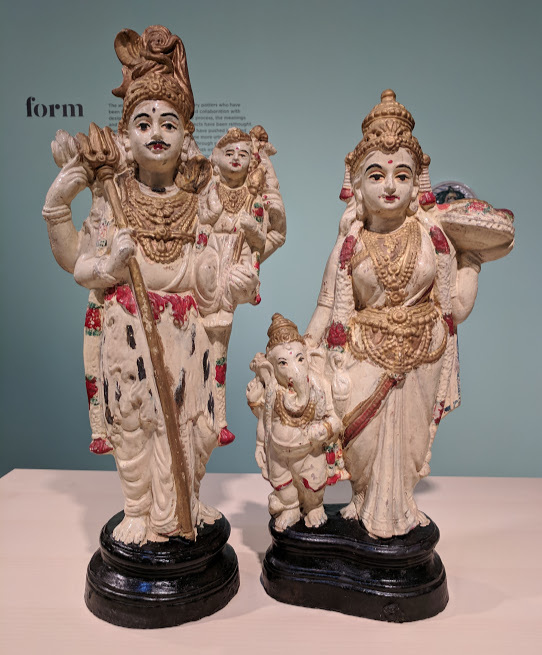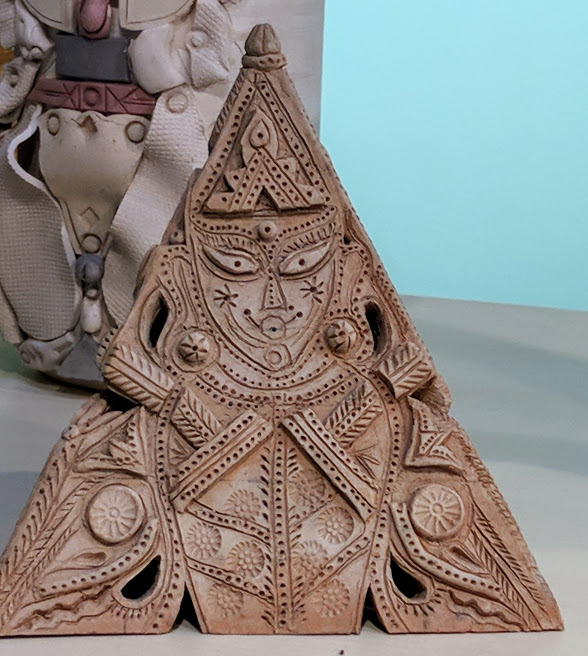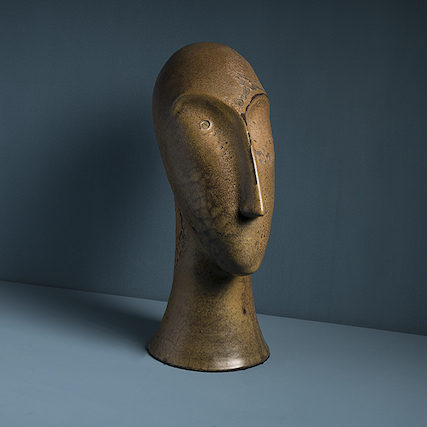FA: Students selected for Serendipity Barefoot School of Art Competition 2017
A Group of 8 thesis semester students from Faculty of Architecture, CEPT University have participated in Serendipity Barefoot School of Art competition and got shortlisted for exhibiting their work in the Serendipity Arts Festival in Goa(December 15th – 22nd). A total of 15 proposals will be exhibited in the festival along with their proposal.
About competition:
The intent of the project is to create new centres of learning for crafts and a space where this legacy can be taken forth through instruction and hands on experience. What is expected of the design is a statement on the very idea of teaching crafts. To conceptualize a space for learning which addresses the need for design intervention is a learning space.
Facebook link for the festival –
https://www.facebook.com/serendipityartsfestival/
The name of the students as per the photo attached (left to right):
Vedanti Agarwal
Nishita Parmar
Krishna Parikh
Manuni Patel
Aman Amin
Prashik Chaudhari
Monik Shah
Kishan Shah
The jurors for the competition are Aniket Bhagwat, Dr. Annapurna Garimella, Judy Frater and Shruti Narayan who shortlisted their entry.
As a group, they have recently started a new firm under the name – Compartment S4. It is an architectural collaborative by a group of designers who have come together to combine their individual ideologies in a pool of ideas which can enhance architecture further.
Follow on the Facebook page link –
https://www.facebook.com/Compartment-S4-1359558187472135/
Reposted from: http://cept.ac.in/faculty-of-architecture/news/fa-students-selected-for-serendipity-barefoot-school-of-art-competition-2017
Serendipity Barefoot School of Craft: Made in Goa
Serendipity Barefoot School of Craft: Made in Goa is an architectural competition. The selection of 15 submissions for development into architectural models will be displayed at Serendipity Art Festival 2017, with the selected submission being developed into a school of craft in 2018. Submission for this newly launched open architectural competition seek to raise awareness about the importance of our continued and collective engagement with local environments, skills, materials and crafts pedagogy
Discipline Curator: Dr. Annapurna Gerimella
Design & Research in collaboration: Mozaic (Dean D’Cruz)
Date: 15th – 22nd December 2017
About Dr. Annapurna Gerimella:
Dr. Annapurna Garimella is a designer and an art historian who focuses on the art and architecture of India and is based in Bangalore, India. She heads Jackfruit, a research and design organization, with a specialized portfolio of design and curatorial projects for artists, museums, government and private organizations and non-profits. Jackfruit’s most recent project is Vernacular, in the Contemporary for Devi Art Foundation, New Delhi. She is also founder of Art, Resources and Teaching Trust, a not-for-profit organization that gathers resources and promotes research and teaching in art and architectural history, archaeology, crafts, design, and other related disciplines in academic and non-academic fora. She was the former Research Editor and Advisory Board Member for Marg Publications and is currently on the board of the S N School of Art and Communication, University of Hyderabad. She has written several essays on contemporary art and edited and contributed to two volumes, Shaping the Indian Modern on the work of Mulk Raj Anand and along with Bhanu Padamsee, Akbar Padamsee: Work in Language. Her most recent book is about a collaboration between a Rajasthani miniature painter and expatriate American photographer and is titled The Artful Life of R. Vijay (Serindia, 2016)
“MUTABLE”: THE CHANGING NATURE OF CERAMIC AND CLAY ART IN INDIA
I love experiences that challenge me, make me think and occasionally shake me up a bit — not too much, mind you, just a little. Be it a book, travel, a music performance, food… the memories that have stayed with me are the ones that offered something extra by way of perception. The exhibition on “Mutable: Ceramic and Clay Art in India since 1947“ at the Piramal Museum of Art in Mumbai was one such experience. Curated by Sindhura D.M. and Annapurna Garimella, Mutable showcases 70 years of ceramic and clay art objects sourced from artists, artisans, institutions and private collectors from across India.
I wasn’t aware of this exhibition till photos of its preview night on October 13, 2017, exploded on all my social media timelines. Friends who knew of my interest in all things art tagged me and I went dizzy just keeping up. In the days that followed, tantalising articles and write-ups in newspapers followed, tempting me to drop everything and visit the exhibition, but as it happened it took me 10 days before I could actually do so.
It was my first visit to the Piramal Museum of Art and when I walked in on that October afternoon, I didn’t know where to look first — the large open exhibition space or the exhibits. Exhibition spaces fascinate me in how they are designed to interact with the exhibits within and also how their very design enhances or limits viewer experience. In this case the large open gallery, a viewing gallery on the first floor, a domed roof and the exhibits promised a great experience.
And I wasn’t wrong.
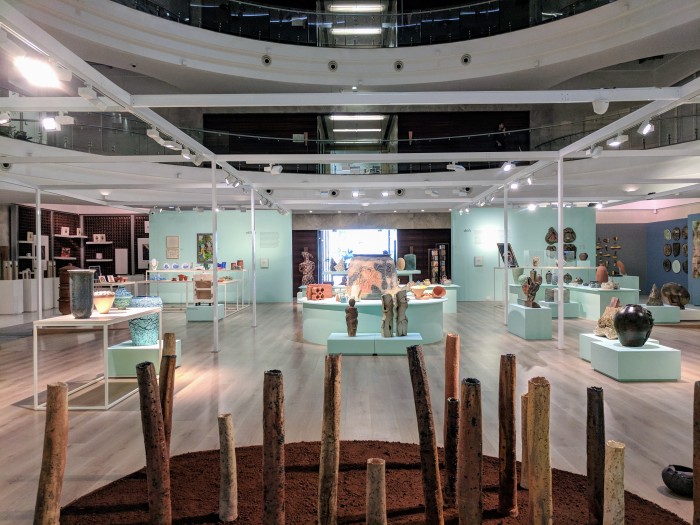
I wasn’t sure what the word “Mutable” meant and had to look it up in the dictionary. According to the Merriam-Webster Dictionary, it means ‘prone to change’ and in the context of the exhibition it means the changes that have taken place in ceramic and clay art in India over the last 70 years.
The Mutable exhibition maps this through 5 sections — Shift, Utility, Form, Object and Perception — with each section addressing “diverse practices, and showcases the works of potters, ceramicists and artists” during the creation of a modern and decolonising India. The exhibition also looks at the works made outside “any specific ideological and institutional frame”, and also objects that were created “through collaborations between potters and artists, artists and industry, studio practitioners and hereditary potters, and between organisations and potters”. In brief, the exhibition sought “to record the… history of the art form and its makers and to explore the boundaries that exist between the ‘traditional’ and ‘contemporary’”.
I took my time to go through the exhibition, and then going back to see the ones I liked, taking my time to understand make the connections between the exhibits and the word “Mutable”. For example, one of the first exhibits I saw was a surahi or a traditional water pot and placed next to it were two modern interpretations of the surahi. Though they looked quite different, they were still recognisable as a surahi. So, while the design had become mutable, its functionality had not.
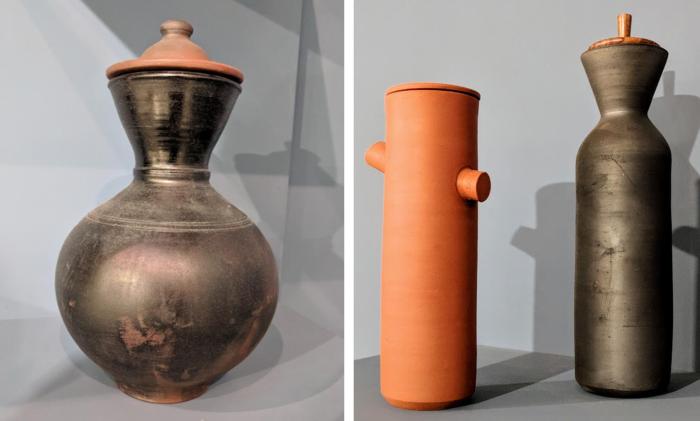
My favourite exhibit was Sudhir Patwardhan’s “Untitled” terracotta work, which at first glance looked like a big slab of pink sandstone. As I looked closer, it revealed surprising details — a tree, and beyond that an undulating landscape. Were undulations mountains or sand dunes? Did the two distinct portions convey a meeting of the traditional and the contemporary? Did this convey the mutable, ever-changing nature of the earth? The terracotta was so compelling that my hands reached out to touch the terracotta slab involuntarily. The ever-watchful security guard cleared his throat loudly and I withdrew my hand guiltily.

Untitled by Sudhir Patwardhan. Terracotta. 1988
There were surp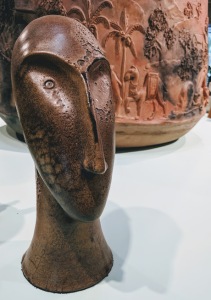 rises and discoveries to be made at the exhibition ! Like Jaimini Roy’s hand-painted work on terracotta. When I saw the hand-painted work, I immediately recognised it as a Jaimini Roy work, but since I only knew of his paintings I had to check and was surprised to find that it was indeed his ! [PS: I also didn’t know that Sudhir Patwardhan worked with terracotta as I only knew of his paintings.] It was also wonderful and special to see the ceramic sculpture (left) titled “Time” by Rekha Goyal. (Hi Rekha ? ), a batc hmate from my Indian Aesthetics programme at Jnanapravaha
rises and discoveries to be made at the exhibition ! Like Jaimini Roy’s hand-painted work on terracotta. When I saw the hand-painted work, I immediately recognised it as a Jaimini Roy work, but since I only knew of his paintings I had to check and was surprised to find that it was indeed his ! [PS: I also didn’t know that Sudhir Patwardhan worked with terracotta as I only knew of his paintings.] It was also wonderful and special to see the ceramic sculpture (left) titled “Time” by Rekha Goyal. (Hi Rekha ? ), a batc hmate from my Indian Aesthetics programme at Jnanapravaha
The scope, magnitude and importance of the Mutable exhibition revealed itself much like Sudhir Patwardhan’s untitled terracotta — slowly, bit by bit, sometimes bold and clear, sometimes nuanced and subtle, sometimes filling me with nostalgia and sometimes with wonder. I loved some of the exhibits, liked most, while a few left me indifferent and puzzled. A selection of some of the exhibits that I loved/liked are given below.

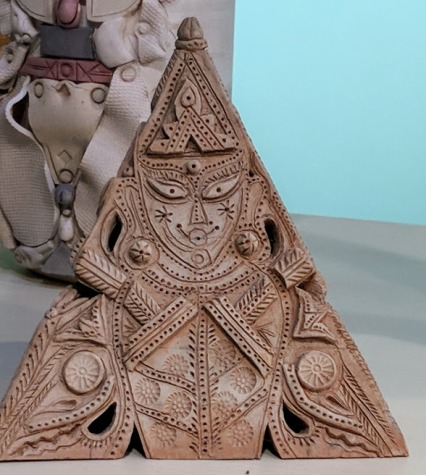
I’m definitely one of those who has taken clay and ceramic art for granted. But this was not always the case. When I started working in 1993 and also started travelling to various places, apart from books, I bought clay and ceramic art — for use at home, as souvenirs, as gifts, etc. My first ceramic piece was a blue and white vase that I got at an exhibition; my first clay art was a terracotta elephant from Chennai. I still have both of them !
When I reached home after visiting the Mutable Exhibition, the first thing I did was to I look around and see the ceramic and clay art at home. Within minutes, I had assembled this little ensemble (you see in the photograph below) together. Though there were more, I didn’t have the patience to gather them together and thought that this was a representative enough. The oldest in this lot is from December 1993 and the newest is from October 2017 and have come various places like Kolkata, Puducherry, Chennai, Delhi, Jaipur, etc.
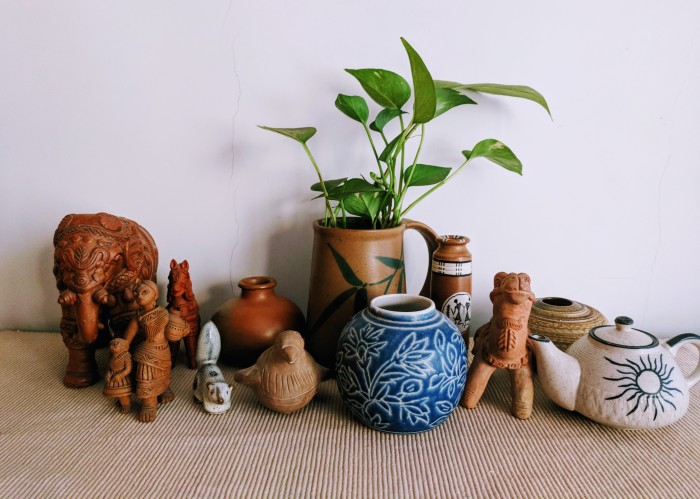
I’m sure there are many like me who have collected and use ceramic and clay art in its various forms. While such people may not and cannot be termed as collectors in the strictest sense —perhaps patron is a better word? — they are important too. For we too have been a part of the changes sweeping through the world of ceramic and clay art in India. And we too have recorded the changes with our little collectibles. Would you agree with me?
As part of the “Mutable” Exhibition, various events and talks were held at the Piramal Museum of Art. While I had the noble intention of attending at least some of them and interact with the artists, and perhaps even visit the exhibition again, that didn’t happen. As the Museum draws to a close next week, I’m just happy that I managed to visit it.
If you are in Mumbai and haven’t visited the exhibition yet, this weekend is your last chance to do so. Please, please don’t miss visiting the Mutable Exhibition. And if you go or have already visited the exhibition, do let me know what you thought of the exhibition.
PS: I received the very timely Marg Magazine on “Indian Ceramics: History and Practice”, yesterday evening, but am yet to read it. Hopefully, it will answer a lot of my questions.
Serendipity Barefoot School of Craft: Made in Goa
Serendipity Barefoot School of Craft is a two-year project which, for this edition of the festival, consists of an architectural competition. The display of all complete submissions and a selection of 15 submissions for development into architectural models will be showcased at SAF 2017.
The Serendipity Barefoot School of Craft seeks to raise awareness about the importance of our continued and collective engagement with local environments, skills, materials and crafts pedagogy.

1. Space Intervention
Every year since 2000 the Serpentine Gallery has commissioned a temporary summer pavilion by a leading architect.
In 2017 Gando, Francis Kéré has designed a responsive Pavilion that seeks to connect its visitors to nature – and each other. An expansive roof, supported by a central steel framework, mimics a tree’s canopy, allowing air to circulate freely while offering shelter against London rain and summer heat.
Kéré has positively embraced British climate in his design, creating a structure that engages with the everchanging London weather in creative ways. The Pavilion has an open air courtyard in the centre where visitors can sit and relax during sunny days. The roof and wall system are made from wood. Similar to the concept of the Serpentine Gallery, the Serendipity Barefoot School of Craft Pavilion will be a sustainable and eco-friendly structure that responds to Goa and shall have an exhibition of architectural models. More importantly, we hope to create a space for an architectural intervention – even in the future.

2. Sustainability
– SAT focuses and has a mandate to respond to Goa as a space and aims to involve the Goan. We are
looking at a pavilion that responds to Goa as well.
– Bamboo as a material must be used.
– Low Carbon Footprint
– The design and production shall need to be based on the use of low skill labour

3. Pavilion shall showcase
– excellence in Design
– proposal entries as well as the 15 shortlisted models
-the space is an intervention of art, crafts, design and most importantly architecture
– post the Festival – it could be a resting point for walkers and visitors
4. Spatial Brief
As per the survey, the site(paved rectangular patch) is approximately 1100 sq.ft. Surrounding area can be used as per design. The structure should be able to host around 40 people at one time and must incorporate all the functions mentioned below:
(i) Oven space where this will be the live aspect of the pavilion where bakers shall
need a traditional oven.
Bake the traditional breads of Goa with some intervention (e.g: adding sea salt)
Allow people and other bakers to come discuss and comment
Maybe sell the breads as well as have tasting for the audiences
The space allotted to this would be 100 sq ft which will include the oven, bread resting racks and fermentation area.
The oven shall cover approximately 60 sq ft.
Remarks: To avoid fire hazards this would need to be outside and not within the pavilion.
Wet space would be needed as water may be needed for the preparation of dough, hand washing and incase of fire hazard.
(ii) Prototyping Area which is only for
– Showcasing objects made of bamboo
– Highlighting the history of bamboo
Shelves for 10 prototypes like bamboo spectacle frames, bamboo spectacle cases, coconut shell and ceramic buttons, etc
Information and graphics about the prototypes
Information of where the designs come from?
(iii) Main Exhibition Space for
– 15 models and proposals
– 3 to 4 feedback pedestals possibly near the entry/exit with tablets (which would need to be secured). This area would be accessed by the public. The space shall also have the option of a
manual feedback as well, so provision to keep questionnaires printed on recycled paper shall be there.

5. Other Elements
(i) Minimal electricity usage
(ii) naturally ventilated
(iii) – The Pavilion should be one that can be retained for a period of 6 months to year, if permission is given to leave it. If needed to be removed, it should be completely removable without any footprints
(iv) no wet area needed (except in Oven area)
6. Need for Design intervention at Bhagwan Mahavir Children’s Park
We are on a journey to explore and reinvent Panjim as a cultural space, and we believe that interventions through contemporary designs play a crucial role. With “Serendipity Barefoot School of Craft: Made in Goa”, we aim to showcase this intervention with traditional craft forms and sustainable yet contemporary architectural designs.
As we have this journey is one that will expand over the years, we would like to use the Children’s Park for the pilot part of the project and merge architecture and craft, reinventing the natural space through sustainable design and create a foundation for architects to build on in the coming phases of the project.
Vernacular spectacular: Craft goes mainstream at India Art Fair | By Neelam Raaji Times of India
NEW DELHI: It’s pretty rare to see Gond and Madhubani paintings rub noses with the Subodh Guptas and Manjit Bawas. It’s even stranger when the setting is the India Art Fair, where commerce takes precedence over culture.
Tribal, folk, naive or native art — all labels that art historians now vehemently oppose — is usually to be found in craft museums, trade fairs or Dilli Haat. Most contemporary art shows give it a wide berth. At best, you get the odd work hung in the name of “inclusion”.
But with the India Art Fair, once considered a scrappy upstart, becoming more confident of its place on the global art map, it’s decided to not only represent work from across South Asia but also widen the definition of contemporary Indian art to include vernacular art.
At the ‘Vernacular in Flux’ section curated by art historian Annapurna Garimella hang some of the best names in Gond, Mithila and Guruvayoor art. “I feel the term vernacular is more apt as it signifies a traditional art language without the limitations that terms like folk, tribal or native have,” says Garimella, who has borrowed works of artists like Gond’s Bhajju Shyam and Mithila’s Baua Devi from noted private collections.
“Galleries are beginning to put serious consideration into becoming more diverse,” says Garimella. But her worry, shared by many, is that if the market dries up, commitment might dry up with it.
“Mutable”: ceramic and clay art in India since 1947 at Piramal Museum of Art, Mumbai
Reposted from: http://artradarjournal.com
“Mutable” showcases diverse ceramic and clay art objects sourced from artists, artisans, institutions and private collectors from across India.
This landmark exhibition, curated by Sindhura D.M. with Annapurna Garimella, is one of the first of its kind in the city and is on display at the Piramal Museum of Art until 15 January 2018.

Abhay Pandit, Tension of Lines (Seascape), 2014-15, stoneware, h 18 x w 14 in. Image courtesy the artist and the Piramal Museum of Art, Mumbai.
Building links between the vernacular and the modern
Pottery in India has evolved in the last 70 years since attaining independence from its functional aspects as a utilitarian household item into an aesthetic object and work of art, thereby making a place for itself in the contemporary art space of today. This has been an eventful journey. An important aspect of the nation-building agenda of independent India was theengagement of rural arts and crafts with the nationalist discourse. Pottery, weaving and textiles played an equally critical role alongside painting, sculpture and architecture in the development of a new Indian aesthetic as artists tried to revitalise India’s cultural heritage by using indigenous elements in their practice.

Vineet Kacker, Khojun…Ya Kho Jaun (Should I Look For You, Should I Lose Myself), 2016, mixed media. Image courtesy the artist and the Piramal Museum of Art, Mumbai.
During the course of the 20th century, as artists started focusing on individuality, creativity and personal expression, ceramic and clay art developed its own aesthetic language and established itself as a distinct art form – transcending the humble status of its colonial past by incorporating new technologies and modern materials. As stated in the Piramal Museum exhibition brochure,
Mutable: Ceramic and Clay Art in India Since 1947 surveys this changing social, cultural, ecological and visual landscape and explores the enormous range of cultural practices that deal with aesthetics, function and sustainability. The pivotal point of the exhibition is the building of links or bridges between images of the vernacular and of modern art and design.

K Laxma Goud, Untitled and undated, 2017, ceramic, h 21.96 x w 20.98 x d 10.00 in. Image courtesy the Guild Art Gallery, Mumbai and the Piramal Museum of Art, Mumbai.
Diversity, creativity and partnerships
“Mutable” showcases the diverse range of pottery-making in India and displays the works of 80 artists from across the country including Gurcharan Singh who is acknowledged as the pioneer of Indian studio pottery, the versatile Devi Prasad who was a painter, potter and lifelong pacifist, and Ray Meeker and Deborah Smith, the founders of Puducherry’s Golden Bridge Pottery and leading educators in the field of contemporary ceramic art.
It also presents the works of leading artists with heterogeneous practices, who have used clay as one of the various media in their repertoire, such as K. G. Subramanyan, Laxma Goud, Himmat Shah, N. N. Rimzon, Nek Chand Saini and MrinaliniMukherjee. In order to celebrate the efforts of hereditary potters, “Mutable” also introduces visitors to the practices of famous father-son duos such as Delhi-based Bhuvnesh and Giri Raj Prasad (both National Award winners), and Padma Shriawardee Brahmdeo Ram and Abhay Pandit, trailblazing ceramists from Mumbai.

“Mutable”, 13 October 2017 – 15 January 2018, installation view at Piramal Museum of Art. Image courtesy the Piramal Museum of Art, Mumbai.
The exhibition throws a spotlight on ceramic and clay practices as they have emerged out of India’s art schools and also focuses on work done by institutions working with potters across the country such as Fabindia, Neerja International, Gwalior Pottery and Mitotic Commenting. On the vast diversity presented in the exhibition curators Annapurna Garimellaand Sindhura D.M. said:
“Clay and ceramic are vernacular, classic, modern and plural; they change and endure. ‘Mutable’celebrates seventy years of creative work with these materials, presenting an Indian history of ideas, art, design and technology.”

Brahmdeo Ram Pandit, ‘Crystalline Ceramics’, 2016, stoneware, h 17 in. Image courtesy the artist and the Piramal Museum of Art, Mumbai.
Tradition meets technology
As the makers of utilitarian pottery in India have historically been artisanal potters, artists have always been involved in reviving traditional techniques while assimilating new technologies into their ceramic and clay practices. This is clearly evident in the heterogeneity of styles, textures, designs and purposes of the objects on display at “Mutable” which are organised into five sections – ‘Shift’, ‘Utility’, ‘Form’, ‘Object’ and ‘Perception’. Commenting on the broad range of practices of the featured potters, artists, ceramists and organisations that have been working with clay, exhibition curator SindhuraD.M. says:
“Respecting this diversity, the term ‘maker’ is privileged throughout the exhibition to describe and place potters, artists and ceramists in a broader field of ceramic and clay practice. Some makers produce more than one type of work which may include functional ware as well as sculpture. This has led us to include them in more than one section in the exhibition . . . The vast diversity of today’s work with clay, which is presented in this exhibition, is an indicator of the change that is happening within practices.”

Aman Khanna, Acute, Obtuse, Straight and Right, 2017, ceramic/stoneware, h 12 in approximately. Image courtesy the artist and the Piramal Museum of Art, Mumbai.
It was artist Gurcharan Singh’s experience of Japanese studio pottery that enabled him to push the boundaries of form, technique and material and introduce stoneware, dull glazes and unusual shapes of tableware in his practice – evident in the exhibition “Kettle, Coffee Cup and Saucers”. In the 1970s, it was the pioneering efforts of artists such as Singh and others like Ray Meeker and Deborah Smith who started Golden Bridge Pottery in Puducherry that paved the way for the younger generation of potters to explore new techniques and develop their creativity. Artists such as Vineet Kacker’s work conflates art, design and craft. Exploiting the tactility of clay, he is able to incorporate layers of meaning into his work by expanding its capacity for creative expression. In Khojun…Ya Kho Jaun (Should I Look for You or Should I Lose Myself)(2016) Kacker merges the earthiness of clay with the modernity of digital technology to create a multimedia installation that urges you to question the spiritual connection between the medium and nature.

Daily Dump, Khamba 3T, 2017, Terracotta, 15.5 x 30.5 in. Image courtesy the Piramal Art Foundation, Mumbai.
In the ‘Utility’ section of the exhibition due recognition has been given to commercial organisations such as Gwalior Pottery and Fabindia that have championed the cause of developing utilitarian items while providing sustainable livelihoods to many generations of potters. This section also includes some unconventional products such as Daily Dump’s Khamba 3 T(2017), a terracotta composter, and Mitticool’s terracotta Refrigerator (2017), which shows that out-of-the-box thinking has given new life to age-old craft techniques. ‘Form’ features the work of traditional potters like Brahmdeo Ram Panditwho received the Padma Shri, the fourth highest civilian award in the country, in 2013 and was adept at using different glazes – a skill he acquired by training in several institutions across the world and imbibing international best practices todevelop a studio pottery enterprise.

Gwalior Pottery, Small Milk Jugs. Image courtesy the collection of Anuradha Ravindranath, New Delhi and the Piramal Museum of Art, Mumbai.
Diversity in expression
In an attempt to highlight the role played by clay as a medium of creative expression that redefined the art of modern day India, ‘Object’ includes exhibits such as the works of artist and educator K. Subramanyan and his student K. Laxma Goud. Subramanyan supported the Gandhian philosophy of promoting indigenous arts and crafts and urged his Santiniketanstudents to derive something new from the familiar, everyday objects. This is evident in Laxma Goud’s untitled work which is on display in “Mutable” that has the artist using his customary rustic vivacity and earthy style to layer paint on a humble clay plate.
In ‘Perception’, the visitor is urged to look beyond material, tradition and purpose, to acknowledge the importance of the design, the technique and the identity of the maker. Water pots from different parts of India that are on display here show how different artists and artisans explore aesthetics and functionality in a manner unique to their geographical location, cultural background and education.

Gurcharan Singh, Kettle, Coffee Cups and Saucers, 1970s, acrylic, fabric, plywood, glue, fibreglass, iron, rexine, plastic and crystal, 77 x 40 x 28 in. Image courtesy the collection of Anuradha Ravindranath, New Delhi and the Piramal Museum of Art, Mumbai.
It is this conflation of characteristics of the medium that gives it an aesthetic beauty and technological complexity that transforms even the functional and the utilitarian into a work of art. It is this creative diversity in clay and ceramic practices that “Mutable” seeks to celebrate.
Amita Kini-Singh
1926
“Mutable. Ceramic and Clay Art in India since 1947” is on view from 13 October 2017 to 15 January 2018 at Piramal Museum of Art, B Wing, Piramal Tower, Peninsular Corporate Park, Lower Parel West, Mumbai 400013.
Related topics: Indian, ceramics, identity, technology, museum shows, Mumbai
Related posts:
- Exploring Buddhist cosmology in ceramics: China’s Geng Xue – artist profile – May 2017 – Art Radar has a look at her current exhibition as well as her artistic practice
- 11 Artists from the Jakarta Contemporary Ceramics Biennale 2016 – December 2016 – the fourth edition of JCCB presents 43 artists from countries worldwide
- “Silver Bird”: an exploration of ‘flying’ with Indian artist and cinematographer Shambhavi Kaul – in conversation – November 2017 – Art Radar spoke to Kaul about the ideas behind both the exhibition on display at Jhaveri Contemporary
- “Crystal Cities”: Indian artist Jagannath Panda at Dr Bhau Daji Lad Museum, Mumbai – October 2017 – the exhibition comes nearly 10 years after Jagannath Panda’s last solo show and is on display at the Dr Bhau Daji Lad Museum until 29 October 2017.
- “A fly on the wall”: Sooni Taraporevala on Mumbai, VR and more – interview – August 2017 – the show features 30 black and white photographs by Taraporevala spanning four decades
KGAF 2017 – The Sharada Dwivedi Commemorative Lecture
‘Amidst the Art Public: Writing as Analysis, Exhortation and Reflection’ — by Annapurna Garimella. Chaired by Ranjit Hoskote
Launch of Peaking Duck Diaries & Speaking Duck Annapurna Garimella | 17th May 2013
Peaking Duck is a Bangalore based network of inter-disciplinary, like-minded creative practitioners who have come together towards a common vision and goal. The network has been started to joyfully celebrate our creative passions instead of lamenting our limitations and the paths we have yet to traverse. The network acknowledges that we as artists always seek to intensify our individual and collective experiences — with an aim to keep peaking. To do so collectively would allow us to hope and imagine a Bangalore which would move beyond the half promises we have so far witnessed. This is why we have decided to call ourselves the “peaking duck” network.
Locating Folk Art in the world of Art, Design and Commerce | Piramal Museum of Art
Locating Folk Art in the world of Art, Design and Commerce This panel discussion hosted at the Piramal Museum of Art, Lower Parel, addresses the transforming role and visibility of Indian craft in contemporary times through the initiative of designers, auction houses and galleries. It engages with the increasing financial transactions surrounding craft and the inherent unevenness surrounding the same since the popularity of craft ensures that it finds a place in designer stores and auction houses as well as in craft melas and rural markets. However there are complex issues here regarding authorship, tradition and creativity that need to be taken into consideration while dealing with the economics of craft. These issues form the core points of discussion in the panel moderated by art historian and curator Dr.Annapurna Garimella. Speakers: Mr. Amit Kumar Jain – Associate Vice President of Saffronart Ms. Nancy Adajania – Cultural Theorist and Curator Ms. Radhi Parekh – Founder of ARTISANS’ Moderated by Dr. Annapurna Garimella
Melbourne Art Fair 2012 Lecture and Forums: The Vernacular Contemporary: Annapurna Garimella
Melbourne Art Fair 2012 Lecture and Forums: The Vernacular Contemporary: Annapurna Garimella
Annapurna Garimella
Director of Jackfruit Research and Design | Melbourne Art FaIr Lectures and Forums curated by Helen Hughes
Abstract: Contemporary vernacular art in India includes craft, folk, tribal, ritual, temple, classical, domestic, self-taught and sometimes popular art forms and practices. This umbrella category sees and produces a collaborative and conflictual relationship between these various art forms and also acknowledges the inherent diversity of the vernacular art sphere, while also positioning them in a critical, questioning relationship with the prevalent idea of the contemporary. Garimella will discuss these issues through the history of exhibitions and specific curatorial practices in modern, post-Independence India and conclude by thinking about how contemporary vernacular and Anglophone artists engage with the idea of the vernacular.


